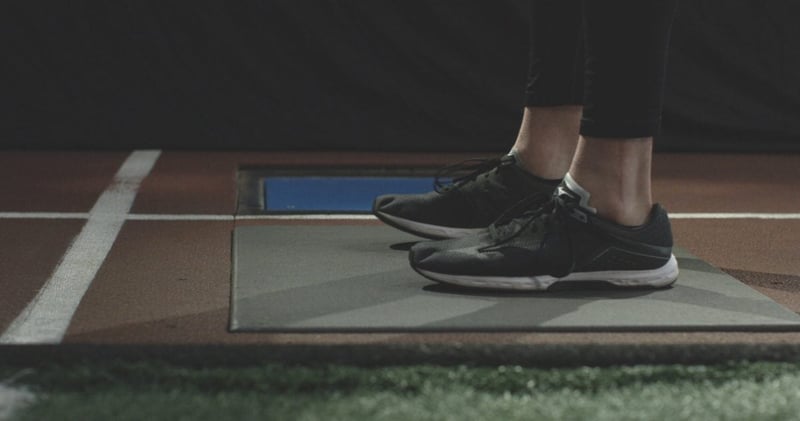
A Force plate or platform is a device used to measure the forces exerted on the ground by a human body (see image above).
In essence, they act as sophisticated bathroom scales, but their potential goes far beyond just measuring your weight. These devices are equipped with load cells that can convert physical forces, such as pressure, into electrical signals that can be precisely measured and standardized.
The load cells are important for several reasons:
In the late 1970s, companies like AMTI, Bertec, and Kistler introduced force plates into clinical and biomechanics labs. These settings often combined force with additional research-driven data collection to identify gait abnormalities and other Movement Health related ailments.
This raw data generally consists of time-series data, providing an objective measure of force (in Newtons) for every millisecond of time during data capture. This data would then be input into engineering software to calculate different variables of interest, then typically exported to spreadsheets for analysis in statistical software for eventual analysis and publication. Due to limitations in terms of manpower, as well as the tedious multi-step process for data collection, processing, and analysis, this was primarily done in research settings with small datasets.
Over the past decade, we've seen a surge in commercially available products for practitioners, such as ForceDecks, Hawkin Dynamics, and, of course, our own Sparta Science Scan Kit. Due to improvements both in the manufacturing of hardware and computer processing, these solutions offer more affordable and more portable options for force plate hardware and faster, more user-friendly software.
While the force plate technology of the 1970s was built for the lab, today’s force plate technology is ubiquitous.
Sports teams, physical therapy clinics, military human performance environments, and maybe even your local gym! So, while basic technological advancements have helped to bring force plates out of the laboratory, what is the next evolutionary advancement for this data source?
Force plate machine learning can supercharge analysis and insights by combining these two technologies! The easiest way to illustrate the potential for ML with respect to force plate data is related to the granularity of data capture force plates allow. As mentioned earlier, most force plates collect data at an extremely high frequency, such as 1000 Hertz or 1,000 points per second.
To use an oversimplified example, if an individual performs a task on a force plate that lasts 2-5 seconds, like a vertical jump or a single-leg balance, and then does that 2-4 times in a row, at the most granular level, we have captured an astonishing 4,000-20,000 data points! Do those same tests on 20 people each week for a month, which grows to 320,000-1,600,000 data points!
With standard analyses and force plate software, those many granular data points are usually resolved into a handful of discrete variables (e.g., rate of force and max power) founded in physics and kinetics, but with machine learning, this full set of time-series data can be analyzed as well!
Scalability becomes particularly challenging for organizations that encompass more than one team, like MLB organizations or military units. In such cases, the velocity of data influx causes volume to grow exponentially and cannot be managed with local solutions or conventional data warehouses. Instead, a sophisticated data science infrastructure, often referred to as a data platform, is needed. Most data aggregation tools, such as data warehouses or management systems, don’t have the capability to store or analyze the time-series data from force plates. To enable force plate machine learning, Sparta Science can save, store, manage, and analyze all the time-series data captured from force plates (or other sensors) within our Movement Health Platform.
When calculated variables are the only stored information, we lose the depth and granularity of data, which greatly decreases its long-term value and integration ability.
Unfortunately, due to the rapid adoption of checkbox-style data collection within the force plate community, many practitioners have come to believe that calculated discrete kinetic variables are synonymous with “raw data.” However, these calculations usually differ between force plate providers, leaving the time-series data as the real future-proof source of truth data.
For ML to be best leveraged, it requires big data. This doesn’t only require a large volume of data, which force plates can clearly provide, but also a large variety of data. True value emerges when we integrate force plate data with other human observation data. Demographics, health records, wearables, and key events, such as performance or injuries occurring near the force screening. This requires both a flexible and secure infrastructure to store and manage other relevant and often private, sources of human observation data. Data visualization and dashboarding are no doubt valuable tools, but are relatively simplistic and, like force plates, are now everywhere. Advanced analytics like machine learning provide a leap forward for data-driven decision-making.
Where machine learning provides value is finding the patterns we don’t know or can’t see and that are too complex to identify in the traditional approach.
What's even more valuable is the integration of machine learning models within the software. The big data approach goes beyond the limitations of traditional experimental methods and offers a truly unbiased approach to understanding complex data. It allows us to discover what we don't know, as it's not influenced by emotional attachments to specific outcomes.
The fields of sports science and health technology are undergoing a transformation. Big tech giants no longer compete solely based on hardware or software features but on data, insights, machine learning, and prediction capabilities. The sooner we embrace this unprecedented value, the better we can serve athletes, patients, and warfighters with advanced knowledge and solutions. Force plates and machine learning are at the forefront of this revolution, reshaping how we understand and utilize human observation data in unprecedented ways.